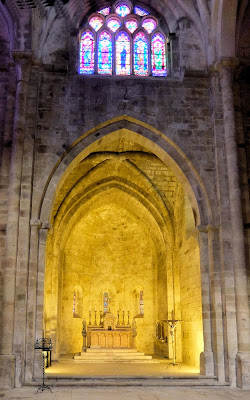
The problem with digital photography is that you take too many shots when
traveling. Although I use to clean out as many photos as possible on the evening
of an exciting day, there remain enough pictures that I take home. Then I sit in
front of my computer and spend hours selecting the best shots and
"photoshopping" them.
What follows is a
continuation of the report about my trip to the cathedrals south
in Cathar land, visiting Fontfroide Abbey, Narbonne, and Carcassonne.
L'Abbaye Sainte-Marie de Fontfroide
Our group visited this former Cistercian monastery located in a secluded valley
15 kilometers southwest of Narbonne. With
Pope Innocent III, the Abbey fought the heretical Cathars, who were particularly strong in the
region. Like many monasteries, the Abbey was dissolved during the French
Revolution.

|
|
Church and cloister
|

|
|
A well-kept cloister garden
|

|
|
Effective lighting inside the church
|

|
|
Peter Kalchthaler explains a reliquary altar.
|

|
| A medieval pieta |
Narbonne
The Romans established Narbonne in 118 BC, as
Colonia Narbo Martius. It
later became the chief city of the Roman province
Gallia Narbonensis.
Narbonne was located at the crucial crossroads of the
Via Domitia, the
first Roman road in Gaul, built at the time of the colony's foundation and
connecting Italy to Spain and the
Via Aquitania connecting the
Mediterranean via Toulouse and Bordeaux with the Atlantic.

|
|
An uncovered stretch of the original Via Domitia in front of the
bishop's palace
|
Later the two "seas" were linked by the Garonne river/canal and the Canal du
Midi, to which Narbonne is connected by the Canal de la Robine.

|
|
Shady promenade along the Canal de la Robine
|
We arrived in Narbonne in time for lunch. With a full dinner in the evening, Red
Baron generally looks for small things to eat. Strolling along the Canal de la
Robine, I found a place serving
Pastis and later had a
Sable Occitan.

|
|
Classical set-up: Pastis 51, water, and ice cubes
|

|
|
Cookies formed like Occitan crosses.
|
While eating my cookie, I contemplated Narbonne's war memorial for the wars of
1914 - 1918, 1939 -1945, and T.O.E?
For me, as a physicist, the abbreviation means
Theory of Everything
but a closer look in Wikipedia revealed that it stands for
Théâtres d'opérations extérieures, somehow mantling the wars France fought in Algeria, Morocco, and Tunisia
(1952 - 1962) and in Indochina (1945 - 1952) until the US-Forces took over.

|
|
A war memorial showing the Gallic cock
|

|
|
Gallic cock from behind, eventually announcing PAX (peace)
|

|
|
Narbonne's former episcopal palace
|
Narbonne's former episcopal palace is now used as a city hall. The connected
Cathedral
Saint-Just-et-Saint-Pasteur, one of the tallest in France,
was never finished. The rear of the ambitious building is frozen in time. The
continuation of the 41-meter-high nave would have required demolishing the
city wall dating from the 5th century. Historians evoke several reasons why
the wall was not torn down. The most important causes were the waves of plague
between 1348 and 1355, so it was better to retain the city wall.

|
|
Impressive construction abandoned
|
Carcassonne
The Romans strategically fortified Carcassonne around 100 BC, and the lower
parts of the northern ramparts date from that time. Carcassonne became famous
during the crusades against the Albigensians, for the city was a stronghold of
Occitan Cathars. In August 1209, the crusading army of the Papal Legate, Abbot
Arnaud Amalric, forced its citizens to surrender, avoiding their holocaust as in the case
of Béziers but not their slaughter.
Today with its reconstructed fortifications, Carcassonne is a Disney-like
tourist attraction.

|
The lower layers of Carcassonne's mighty fortifications
date back to Roman times
|

|
|
Basilica of Saint Nazaire and Saint Celse
|

|
Inside we listened to impressive Russian singers
selling their album following their brief performance
|

|
| Saint Roch again |

|
|
Entrance to the fortress proper, nowadays a museum of medieval art.
|

|
Beheaded Pontius Pilate presenting Jesus as
Schmerzensmann (Man of Sorrows): Ecce Homo
|

|
|
Jesus has risen from the dead.
|
Walking through Carcassonne over lunchtime, the following sign caught my
attention:
Degustation of cheese and dry sausage. This looked original
and was just enough to keep my stomach quiet. I decided to down the offered
specialties with a local dry white wine.
While the patron was preparing the selection of cheese and saucisson, a
couple from our group passed by and joined me for the treat, ordering
red wine.

|
|
Atelier du Maître, where the patron prepares the plates
|

|
|
The cheese came in various colors. My plate is in front. The food was
simply delicious.
|
*

















































